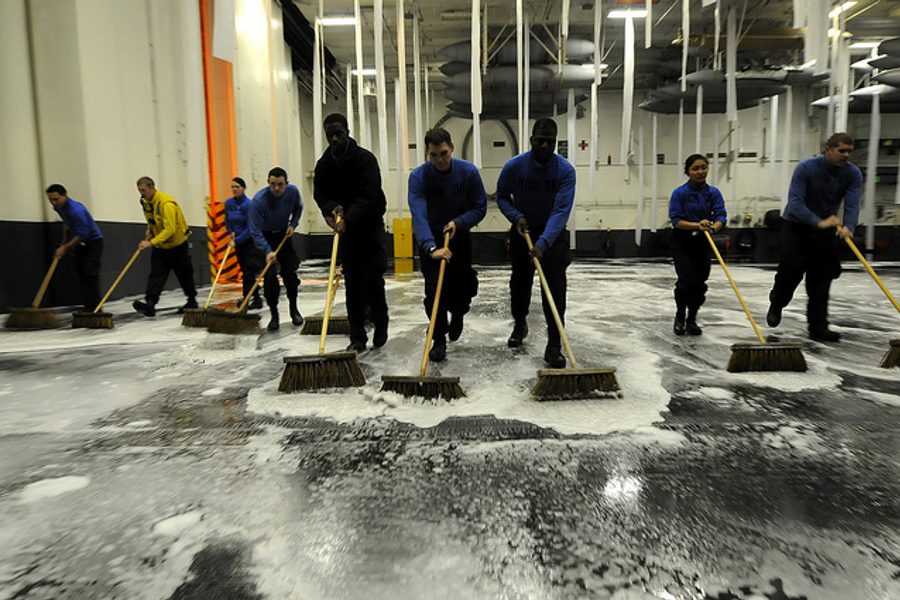Fire Departments, Airports and Military Bases May Be More Toxic to Workers Than You Think
Elizabeth Grossman

Drinking water supplies for at least six million Americans contain toxic industrial chemicals at levels that exceed the U.S. Environmental Protection Agency’s (EPA) recommended safety limit. This number is likely an underestimate since the information available through the EPA does not include data for about one-third of Americans — those 100 million or more people who rely on private wells or the vast majority of public water systems that serve communities with populations of 10,000 or less. These are the conclusions of a new study whose authors include scientists at the Harvard T.H. Chan School of Public Health, the University of California at Berkeley and the California Department of Toxic Substances Control.
The study “is just showing us the tip of the iceberg,” says author Philippe Grandjean, Harvard T.H. Chan adjunct professor of environmental health and University of Southern Denmark professor of environmental medicine. What also remains largely undocumented is the extent of exposure to workers on the frontline of this chemical use.
While industrial sites were previously recognized as sources of these highly fluorinated, toxic and environmentally-persistent compounds, this is the first nationwide study to document that wastewater treatment plants, along with military bases and airports where these chemicals are used in fire-fighting foams, are also contributing significantly to drinking water contamination. The study reports groundwater and surface water near some of these bases and airports with concentrations of these chemicals 1,000 to 10,000 times higher than the EPA’s health advisory level for drinking water.
While the EPA’s May 2016 fact sheet says, “Such contamination is typically localized and associated with a specific facility for example, an industrial facility where these chemicals were produced or used to manufacture other products or an airfield at which they were used for fire fighting,” the new study shows the contamination is much more widespread. The study’s findings suggest that not only are far more people potentially exposed through drinking water than previously thought, but that the military bases and airports where these fluorinated foams are used may be hotspots of exposure. This means that in addition to runoff from these sites, exposure to those working with these foams may be a health concern, as suggested by recent testing that showed firefighters to have elevated blood levels of fluorinated compounds.
What are PFAS?
These synthetic chemicals (they don’t occur naturally) known as poly- and perfluoroalkyl substances, or PFAS, are used in waterproofing, stain and grease-resistant and non-stick coatings. They’re used in clothing, furniture, carpets, paints and food packaging, among other products. They are also used in plastics and computer chip manufacturing, and in the fire-fighting foams used in military trainings and at airports. These compounds have been so widely used over the past 60 years that the U.S. Centers for Disease Control and Prevention (CDC) has found these chemicals in the blood of more than 97 percent of the Americans tested. These chemicals have also been found in newborns’ umbilical cord blood, an indication of prenatal exposure.
Given the well-recognized potential environmental and health hazards of PFAS and widespread exposure, the EPA has recently lowered its drinking water health advisory limit for PFAS. But this is a guideline, not an enforceable standard. The six PFAS compounds that the EPA is now monitoring in drinking water standards are part of the agency’s Unregulated Contaminated Monitoring Rule program. This requires participating public water systems to monitor for certain contaminants and report on their presence. But it doesn’t require public water systems to ensure that the health advisory levels aren’t exceeded.
“Most wastewater treatment plants don’t remove these compounds,” explains study author Cindy Hu, doctoral candidate in environmental health at Harvard T.H. Chan School of Public Health and Harvard’s John A. Paulson School of Engineering and Applied Sciences.
“We’re concerned about these chemicals because they’ve been linked to a wide range of adverse health effects. And drinking water can be an important source of exposure,” says Hu.
Various PFAS have been linked to certain cancers, elevated cholesterol, immune suppression, obesity, low birth weight, reproductive system problems and hormone disruption. Levels of PFAS found in the environment have also been linked to suppressed immune systems in children.
“These compounds are incredibly stable, so they can leach into the groundwater over many years and they stay there,” says Grandjean.
“Their half life is on the order of several years,” explained study co-author Laurel Schaider, research scientist at the Silent Spring Institute. “If you stopped being exposed, it would take a couple of years to reduce levels in your body by half,” said Schaider.
For this reason, says Grandjean, “Even the small contributions” – or exposures – “are what we worry about.”
Even though the EPA recently lowered what it considers a safe limit in drinking water, Grandjean worries that this level is not sufficiently protective.
“Unfortunately, I have to say, the EPA water limits are way, way too high,” he says. The concern is the large “number of people that are exposed to levels that we can see are associated with adverse effects on the immune system and carry risks of miscarriage,” he explains. These are, he says, “levels that we’re not protecting people against.”
Workers on the frontline
The fact that so people are likely exposed to PFAS through drinking water at levels of concern to scientists raises additional concerns for people – like firefighters– regularly exposed on the job.
Existing studies examining firefighters for the presence of perfluorinated compounds in their blood have shown elevated exposure after responding to fires. A study of California firefighters found such levels to be three times higher than that of American men tested by the CDC. That these compounds persist in the body and can produce adverse effects at low levels makes cumulative exposures a concern. For female firefighters there’s the additional concern that these chemicals can be passed on to a fetus or infant.
According to the U.S. Bureau of Transportation, there are about 19,299 airports in the United States, a number that includes both military and civilian airports. And according to the U.S. Bureau of Labor Statistics, there are an estimated 137,300 U.S. workers employed in aircraft maintenance. But, to date, beyond the studies looking at blood concentrations of PFAS in firefighters, the limited occupational exposure studies for PFAS have largely been of workers at plants that manufacture these chemicals. And most such studies have been conducted or commissioned by companies producing the chemicals. Some of these studies have linked exposure to high blood cholesterol. Others have found links between exposure and some increased risk of prostate cancer. But overall, the industry-commissioned studies say there is not yet sufficient evidence to establish a causal link between PFAS exposure and adverse human health effects.
Yet, says Schaider, the studies that might begin to link PFAS exposure to specific health outcomes in fire fighters and others using these foams haven’t been done. Some are now just getting underway, through the International Association of Fire Fighters, which is examining impacts of these fire-fighting foams on women fire fighters. But she says, “Unfortunately, I don’t think this has been addressed yet.”
And while there is ample documentation of “highly polluted water” at airports and military bases where PFAS are used, “epidemiological data on the military is hard to come by,” says study author Arlene Blum, executive director of the Green Science Policy Institute.
The solution? For one, says Blum, “The military needs to needs to investigate alternative fire-fighting foams that don’t contain any highly fluorinated compounds.”
“My key message,” says Grandjean, is that because these chemicals “are so persistent and we are discovering more and more effects at lower doses, we need to vigorously reduce these exposures.” And, he says, for people “who’ve been exposed over a long time, exposures should get as close to zero as possible.”







